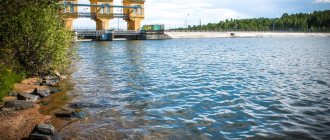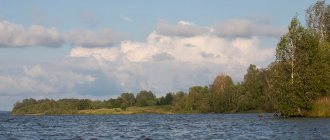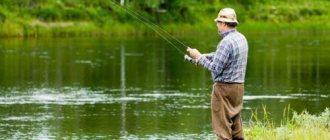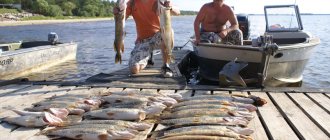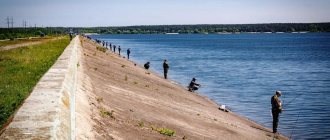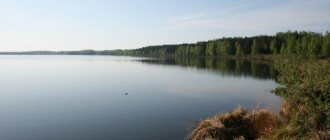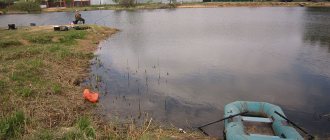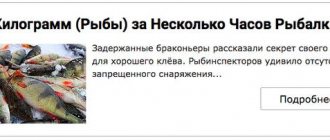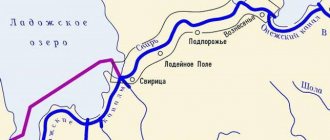“What Russian doesn’t like driving fast!” - exclaimed the hero of Nikolai Vasilyevich Gogol Chichikov. Every keen angler will say the same about his favorite hobby. Winter and summer, under the ice and underwater, with friends and alone, from a boat and from the shore, with aromatic fish soup and delicious fried food - the list goes on and on. “A fisherman sees a fisherman from afar,” and also knows the best places where he always bites. This review contains information about the Mozhaisk reservoir near Moscow.
History and features of the reservoir
The reservoir is located near the highway of the same name in the west of Moscow, just a hundred kilometers from the capital. This is a huge body of water, man-made; people often call it the sea. The reservoir was created during the construction of the Mozhaisk hydroelectric station in the early sixties. Water from it flows into the Moscow River.
The reservoir, with an area of more than thirty square kilometers, stretches like a caterpillar about fifty kilometers long, up to three and a half kilometers wide, and up to forty meters deep. On the territory of the lake near the abandoned village of Goroshkovo there is Gorokhovsky Island with sandy shores, suitable for spending the night with tents.
The banks of the reservoir are generally flat, but there are also steep places overgrown with tall grass and reeds. In the last century, the reservoir was navigable, but in recent years, like other Moscow reservoirs, it serves exclusively to provide the capital with fresh water. Freeze-up occurs in November, ice drift - in April.
Where is the best place to relax on the Mozhaisk Reservoir?
The Mozhaisk Reservoir is truly one of the most beautiful and popular vacation spots within reach for a city or metropolitan resident. Moreover, the tourism season in these parts does not stop all year round.
In the summer, tourists swim in warm fresh water, walk through the forest, picking mushrooms and berries, rollerblade, bicycle and scooter around the grounds, sail on boats, admiring the surrounding landscapes. In winter, winter fishing and hunting are open, and sports lovers go skiing and skating. The water freezes from about the end of November, turning into ice, reaching a thickness of a full meter.
You can go to the reservoir with your whole family or alone, renting a room in villages near the water, or stay on the very edge of the coast, enjoying nature and fresh air. The picturesque surroundings are represented by mixed coniferous-deciduous forests and ecologically clean water expanses of a vast territory.
There are recreation centers on the coast that offer tourism for every taste. Active guests visit the gyms and swimming pools, play football and volleyball, tennis and billiards both outdoors and indoors. Entertainment activities include nightclubs and karaoke. You can eat in cafes and restaurants, which offer entertainment programs in the evenings. Baths and saunas are available for rent on the premises so you can relax on your holiday as you wish.
For lovers of excursions, there will also be exciting activities. If you are staying in the area of the village “Staroe Selo”, visit the island “Gorokhovsky”, located in the very heart of the reservoir. Near it, the water remains shallow, so it warms up very well: up to a temperature of 30 ºС. In August, moderate climate changes begin, characterized by the opening of the velvet season.
Discover centuries-old historical monuments. Go to the Smolensk Church (Church of the Smolensk Icon of the Mother of God), which is made in the amazing Baroque architectural style of late Spain. Create a tour to the Goretovo and Krasnovidovo estates. On the territory of the first there is a church and an ancient outbuilding with a colonnade. The second is famous in the past tense by Marshal G.K., who lives there. Zhukov, who led the staff of the Western Front at the beginning of the Second World War. You can go to the miniature city of Tushkov, interesting to tourists for its protective rampart of impressive high-rise size, protecting against raids until the 15th century.
The Mozhaisk reservoir is made up of artificial reservoirs created in the Moscow region - in its western part. It was named after the district in which it is located; is the largest of the reservoirs located in the region. When going around, it is often called the Mozhaisk Sea.
A reservoir was formed within the Moscow River in 1960...62, after the construction of a hydroelectric complex. The dam that blocked the river is 900 m long; is a car crossing, but travel through it is only possible with passes. Within the dam there is a hydroelectric power station that produces 2.5 MW of power under the condition of a water pressure of 20 m.
The reservoir has an elongated shape in plan and an area of almost 31 sq. km. Its length is almost 47 km, and its width is maximum 3.5 km. The depths of the Mozhaisk reservoir are different in different places, the greatest reach 30 m. Opposite the settlement of Staroye Selo in the water area there is an island named Gorokhovsky.
The banks of the reservoir are different: the left one is almost entirely flat, you can get to it without much difficulty; the right one is much higher, there are cliffs in places. The bottom topography of the Mozhaisk Reservoir corresponds to the floodplain of the Moscow River and is mostly flat. There are a lot of stuck places at the bottom. Greater depths in the reservoir are located within and adjacent to the flooded channel.
There was a time when ships sailed along the Mozhaisk Reservoir, in the Goretovo - Marfin Brod section. Today the reservoir serves to provide Moscow with water and to regulate the flow of water in the Moscow River.
The reservoir and its banks are used for recreation. There are recreation centers around the reservoir, there are many cottage villages and ancient rural settlements. It almost always has fishermen coming from Moscow and more remote regions of the Russian Federation.
The reservoir has recently become heavily overgrown with reeds, especially in its upper part. The time for ice formation on the reservoir occurs in November (end), the time for clear water begins at the end of April.
Features of fishing and main fish
Fishing on the Mozhaisk Reservoir is a favorite pastime of local residents and visiting fishermen. There are a good three dozen species of fish here, both local and artificially bred. On the banks of the reservoir there are several fishing farms that are engaged in “planting” young animals into the water. Bream, ide, perch, silver bream, pike perch, pike, roach, bleak - this is just a small list of the species that can be caught in the reservoir.
You can hunt “for the catch and the smell of fish soup” along the entire coast of the Mozhaisk Sea. According to reviews from experienced fishermen, perch, roach, ruffe and chub are well caught in Krasnovidovo. For bleak, ruff, ide and pike, you should go to the Zarechnaya Sloboda area. Myshkino and Babynino are the best places for catching pike perch, pike perch and asp. People come to Pozdnyakovo and Goretovo for carp and roach. In the area of the village of Levashovo, the shore of the reservoir is ideal for both fishing from the shore and swimming - there is an ideal sandy coastline.
Winter and summer holidays on the Mozhaisk reservoir
If you enjoy outdoor activities such as fishing, then the Mozhaisk Sea may attract attention with its diversity of river fish, of which there are at least 30 different species.
The composition of the inhabitants of the reservoir is represented by pike perch, pike (which is specially bred in the village of Glazovo), perch, ruff, bream, roach, and eel. And less popular representatives, for example, tench, bream, bleak, burbot, dace or silver bream. Sometimes you can catch other families of freshwater from other places that accidentally swam from the Moscow River, thereby ending up in a habitat that is not entirely familiar to them. Such guests include carp and peled.
Often you can get a particularly large specimen on the hook, such as an asp. It can reach as much as six kg, although the average weight of this fish in the Mozhaisk Reservoir is approximately 2-3 kg. Pike perch is also often found large, reaching 10 kg; during normal fishing, count on an individual within 5 kg. You can also find bream fed on bloodworms, although due to its satiety it is not very susceptible to bait.
The abundance of ichthyofauna allowed the Mozhaisk Sea to strengthen its reputation as a good fishing place. Many settlements have special sports facilities for connoisseurs of sport and regular fishing. There you can rent and buy related equipment: fishing rods, nets, fish food, uniforms, even a boat (the use of officially registered small rowing and motor vessels is allowed).
The Mozhaisk reservoir is very long and has a large number of differences with hills (right coast) and depressions (left coast), the average depth is 10-12 meters. Picturesque fishing spots are represented by bays, small islands, rivers and flooded lakes. On the right side of the reservoir there is a steep edge with inherent dense vegetation, on the left side there is a more flat and open space. The bottom is mostly without sudden changes in relief, but there are snags that can get caught on an inflatable boat in shallow water.
Choosing a suitable location
Rarely will a fisherman discover his secret “cool spots,” so here are a few secrets for finding them. Since summer fishing is more common in the reservoir, let’s talk about it first. First, get acquainted with the depth map of the Mozhaisk Reservoir. Secondly, explore the coastal approach to the water, check the bottom topography and try fishing with different baits and different types of gear.
Where the bottom of the reservoir is steep, filled with sand, stones and large pebbles, there is almost no current. It is in such places that large species hide during the day, hunting for small ones - perch, pike, pike perch, and at night and at dawn - catfish. On hot summer days, fish usually hide in shady pools where reeds, reeds and water lilies grow. When fishing from a boat, you should pay attention to “rifts” with a rapid current; they usually give way to deep-sea backwaters, where large species of fish are usually found.
Choosing a fishing method
The best thing you can think of for fishing from the shore is with a fishing rod or spinning rod. Choose the sinker that suits you, the sharpest hook and rod and go fishing. Pike perch, pike, perch and catfish can be successfully fished with a jig spinning rod. At great depths, with a rowing or motor boat, trolling or the colloquially called “track” fishing method, when the bait is towed behind the boat, can be successful. Fans of jig fishing usually return from the reservoir with a large catch.
How to get there
Getting to the Mozhaisk Reservoir is very simple - by car you need to follow the highway of the same name, which starts on Kutuzovsky Prospekt. The highway is wide, high-speed, four-lane, with an additional lane in the middle for government motorcades.
By bus you can go to Mozhaisk from the bus station at the Park Pobedy metro station . Electric trains towards Mozhaisk depart from Belorussky Station from early morning until late at night every twenty minutes. At the Mozhaisk bus station, tickets for regional buses are sold towards villages and towns that are located on the banks of the reservoir.
Advantages
From November until the end of April, a layer of ice covers the Mozhaisk Reservoir. Camping with tents is possible only in the summer (the water temperature sometimes reaches 30 degrees). By the end of August, the velvet season begins on the Mozhaisk Reservoir, the temperature drops slightly. Tourists come with even greater pleasure to relax at this amazing lake.
We recommend visiting the Mozhaisk Reservoir. Camping here in summer is simply excellent! There are a lot of fish in the reservoir. You can catch pike perch, roach, perch, bream, carp, silver bream and other species. That is why the lake is often visited not just for relaxation, but also for fishing. If you are not tempted by camping, you can rent a beautiful house for a few days at one of the many bases, where you can also rent any equipment.
There are also many holiday homes on the shore of the reservoir. In addition, you can use the services of local residents, who are very happy to rent out housing to everyone. Although the amenities attract many who come to the Mozhaisk Reservoir, camping also has some advantages. You can swim and sunbathe for a long time on the fine golden sand. The water in the lake is very clean and warm. The places around are so beautiful that it simply takes your breath away. 15 kilometers from the reservoir is the famous village of Borodino, where tourists are also gladly received.
Fishing bases
We list the most popular and accessible recreation centers on the Mozhaisk Reservoir.
“Ilyinsky Beach”, Blaznovo village. A cozy base with separate comfortable cottages for eight people. In addition to fishing, you can devote time to a bathhouse, walks in a pine forest and relaxing in nature.
"Calypso", Goretovo village. Another base is fifty meters from the water. You can stay in four- or eight-bed houses, as well as in equipped camping areas.
“The Seventh Kilometer”, near the village of Ilyinskoye. A cozy, very budget-friendly recreation center with sports grounds, a mini-farm, catamarans and boats.
Moscow State University Holiday House, Krasnovidovo village, Zelenaya Street, 12. A comfortable holiday house located on a cozy territory of twenty-six hectares. Services, in addition to boat and catamaran rental, include a gym, children's playground, and sports equipment rental.
Beaches of the Mozhaisk Reservoir
Ilyinsky Beach on the Mozhaisk Reservoir is one of the best places to relax in the Moscow region. It is loved not only for its infrastructure and sandy shore, but also for its smooth entry into the water. Another important advantage is that the water temperature in this part of the reservoir is always a couple of degrees higher than in other places.
Access to the beach itself is free. The fee is charged only for entering the parking lot. To make your stay as comfortable as possible, you can rent sun loungers and umbrellas. Showers, changing cabins and toilets can be used free of charge.
Read more about Ilyinsky Beach in a separate article.
Other trustworthy beaches of the Mozhaisk Reservoir belong to the Kalipso and Krasnovidovo recreation centers. On any of them it is easy to organize a comfortable holiday with children or spend time with friends.
There is no single official website for the Mozhaisk Reservoir. The official resources of the tourist centers will help you find out how to get to the beaches.
Ilyinsky beach, © a_gribkova
Winter fishing on the Mozhaisk Reservoir
A special thrill for any fisherman is fishing in the cold season. The bite is best immediately after freeze-up and in early spring. Remember what it’s like to squint in the sun, breathe in the fresh frosty air and rejoice at the catch, of course. When searching for fishing spots, we follow the same rules as for summer fishing. In winter, fish are found in places where algae accumulate or where streams flow into the reservoir. Large fish, as in summer, are found at a depth of at least two and a half meters.
A drill, a depth gauge, winter gear - this is what you will need for ice fishing. The holes should be located at a fairly large distance from each other - at least six to seven meters. The hole must be protected from direct sunlight - darkened with a dark film or sprinkled with snow. We wish you a good bite!
